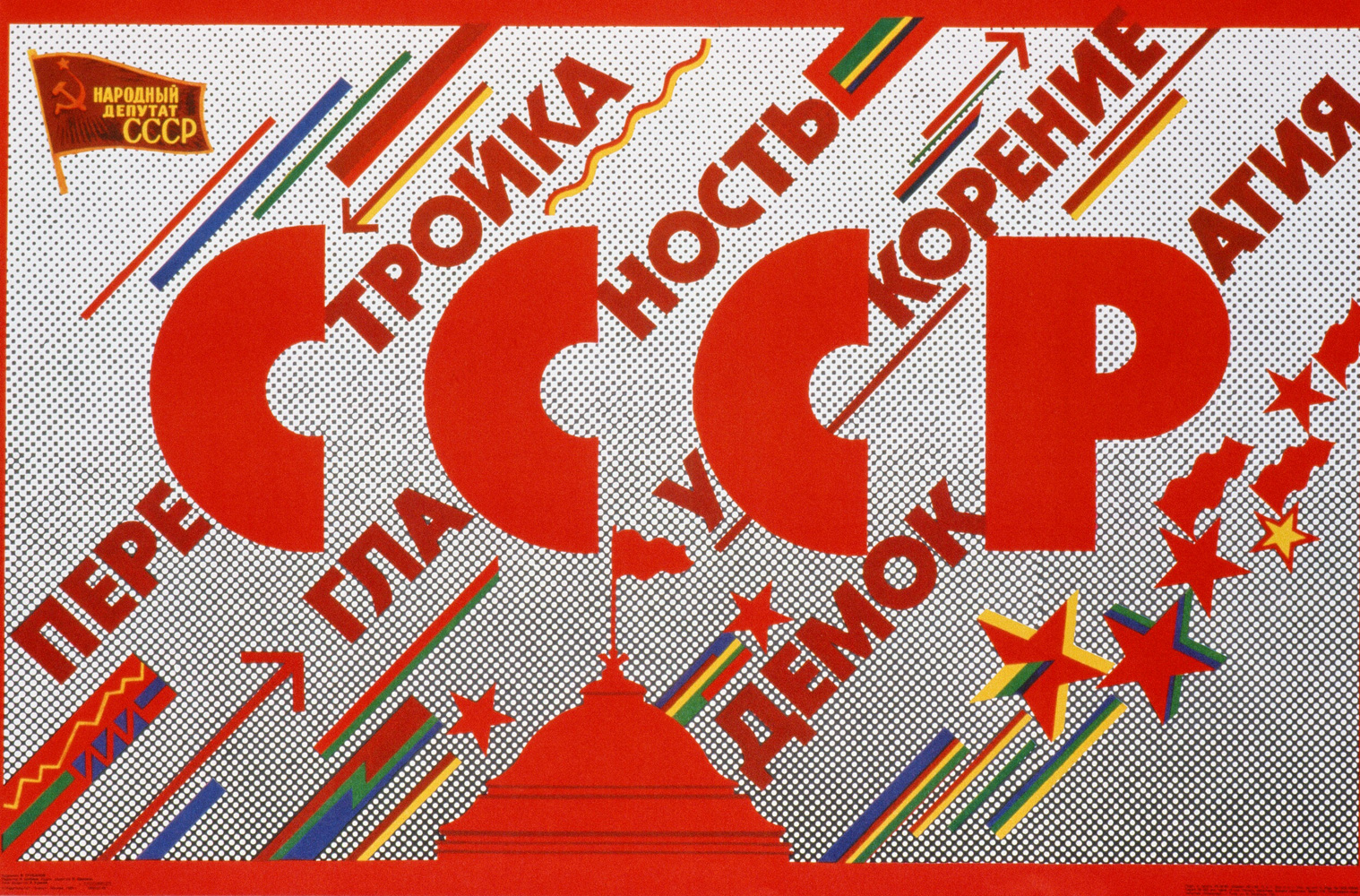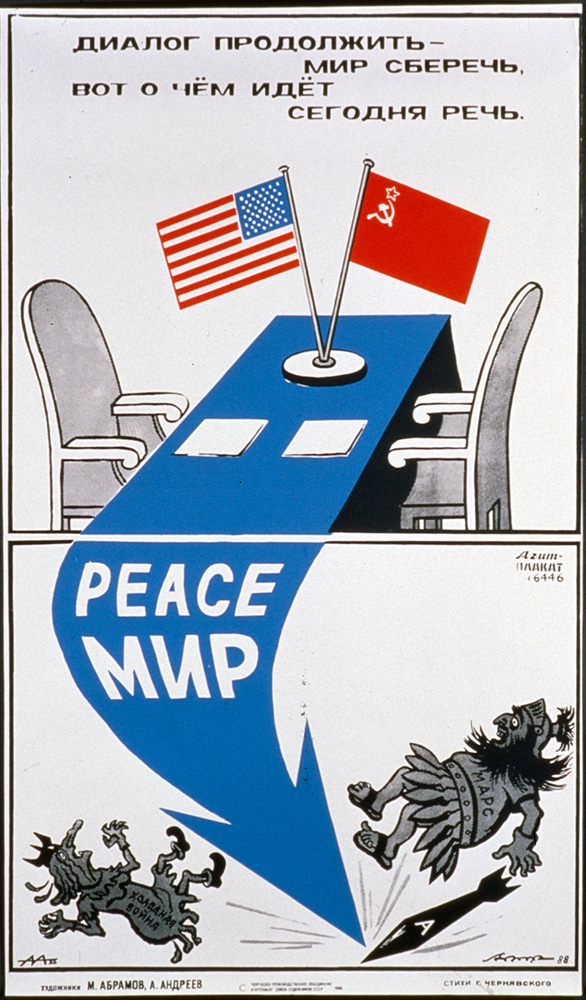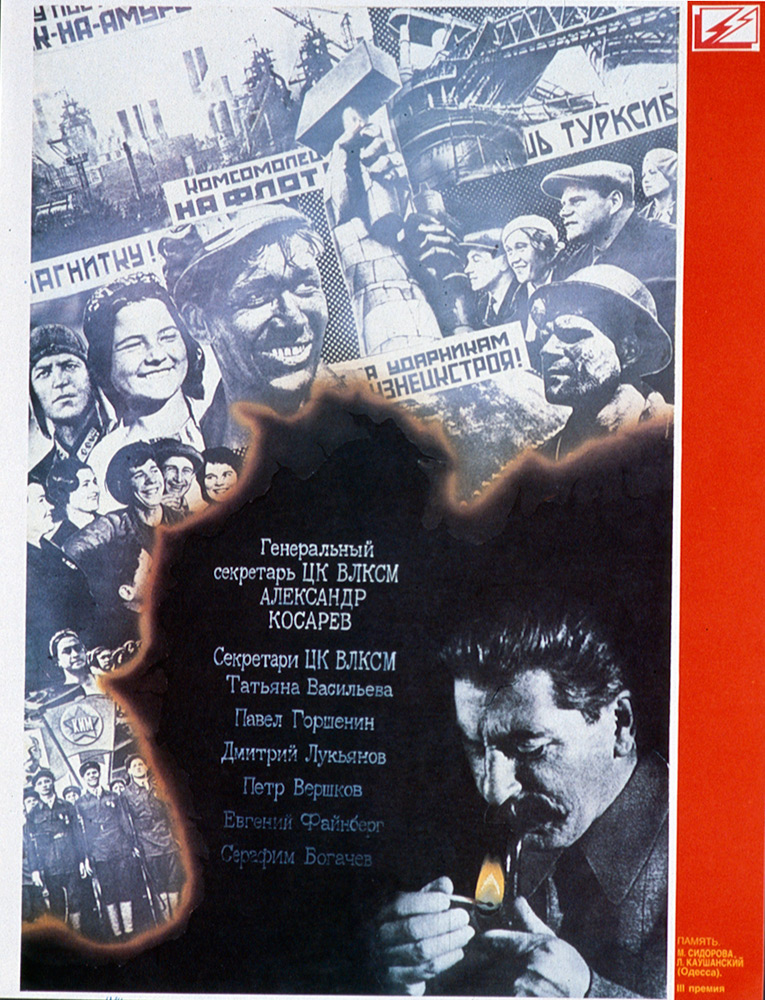
























Posters in this group focus on foreign relations, ideology, and historical issues. The political poster has played a central role in Soviet history since the Russian Revolution of October 1917. The new Communist government faced the enormous task of creating a modern social order from the ruins of a feudal society which was largely illiterate and agricultural. Political posters were recognized as an important ideological tool by the Communist Party for educating the masses about communism, and were an important feature and demonstrations and on special propaganda trains, on boats, and in display windows. In those early days following the Revolution, many posters even carried the warning: "Anybody who tears down or covers this poster is committing a counter –revolutionary act." The subject matter for Soviet political posters has changed through the years. In the 20’s, the focus was on heroic figures representing the masses; in the 30’s posters communicated ambitious economic plans by featuring pictures of factories, power stations, construction sites, and people at work. Posters served an important function during World War II in the fight against naziism, mocking Hitler and exhorting the red Army in the name of the Soviet people. Poster artist and print shops have long been subsidized by the government to communicate official policies and attitudes to the people. With rapid and far – reaching changes in the political situation in the Soviet Union in the late 1980's posters continued to play a dynamic role in mass – communication, as documented in this exhibit of posters.

This poster celebrates the 200th anniversary of the beginning of the French Revolution. The woman, symbol of France, wears the emblem of the French flag on her liberty cap. . The text above her head reads: “200th anniversary of the French Revolution." The words on the banner below, in the tricolors of the French flag, read "Liberty, Equality, Fraternity," the rallying cry of the French Revolution. The style here is from the early tradition of book illustration which dates back before the Russian Revolution.
Arsen' yev 1988

Know who you are voting for!
A visual play on the Russian expression " don't be caught with a cat in the bag." The hand – stitched bag with the cat inside represents the ballot of a voter who is uninformed about the candidate and the issues.
Kuznetsov 1988

1937
A reminder of the black period under Stalin which many people were sent to Siberia and killed.
Savostiuk 1988

USSR. Perestroika, glasnost, acceleration, democracy
USSR is spelled out using letters from these for words. The picture at the bottom is the Kremlin.
Trubanov 1989

The Bureaucrat: I would gnaw out bureaucracy like a wolf.
The figure on this poster is the Russian poet Vladimir Mayakovski (1893-1930), well known for his political poems written during the revolution of 1917.
Artist Unknown 1987

The machine that suppressed the people needed "a screw."
An oppressive system, symbolized by the figure in the military uniform, require the services of the unsavory characters represented here, the carrier of the 'anonymous' letter, the assassin, the politician, and the 'boot – licker.' The implication is that under the new reforms, these characters are no longer wanted or needed.
Ivanov 1988

Continue the dialogue, preserve peace, this is what today's discussions are about.
The spirit of disarmament talks between the U.S. and the U.S.S.R is represented by the bold blue arrow bearing the word for peace in both English and Russian, striking like a lightning bolt, and scattering the figures representing the cold war, on the left, and Mars and the nuclear missile on the right.
Abramov and Amdreyev 1988

Who lives in the tower?
The word for “tower” is a name used in the past for a rich person’s house. The expression comes from a well-known children’s fairy tale, but this house is made of Russian money. The poster questions how people can become rich under the system, an implicit critique of speculation, bribery, and embezzlement.
Artist unknown. Date unknown

He hurries to give support to anything when the authorities give permission.
Satirizes the man who does not use his own head but changes his position depending upon which way the wind is blowing.
Ivanov 1988

Dialogue leads to peace and friendship. Commercial ties are the token of friendship.
Winged Mercury brings a message from the Soviet Union to the United States. In the Roman mythology Mercury represents not only communications, but commerce, property, and wealth. Mercury is also the god of the healing arts; the caduceus represents the hope for healing the differences between the USSR and the U.S. through increased trade and better communication.
Vertogradov 1988

I have no problems.
With his back turned and his ears covered, the man sees nothing and hears nothing.
Lozenko 1989

Down with the window dressing.
A pretty picture is painted of production on the farm, with a hole cut out, like a “photo booth” at a fair. The farm manager can step up and have his picture taken with a bountiful harvest. But the reality is more like the background-grey, bleak, and lifeless. The poster calls for an end to pretenses about farm production. The red strip along the edge represents a soviet arts award.
Chervotkin
Date unknown

Stalinism
Illustration of Stalin without eyes, wearing a modern-day suit. This suggests that Stalinism lives on even today, in the guise of a (non-military) business man. This is a warning that Stalinism can appear in other forms. Part of the new spirit of glasnost involves official acceptance of sharply revised estimates for the numbers of victims of Stalin’s repressive measures. Soviet historian Roy Medvedev recently estimated the total figure at “no fewer than 10 million people,” although he notes that there are no official statistics available. in 1989 a society in memorial of Stalin’s victims was formed and proposed a monument encompassing a museum, archive, and library.
(Third prize) Lebnov.
Date unknown.

We’ll put an end to corruption everywhere. An answer to those who dare to live dishonestly.
The octopus hiding his face behind this official desk has wrapped his tentacles around a fortune in rubles, a commentary on greed and corruption in the bureaucracy. These posters addressing the people on problems in the bureaucracy seem puzzling at first. The average person in any system seems to have little control over entrenched bureaucratic practices. However, President Gorbachev has announced that he intends to persuade Soviet citizens to “take responsibility for their actions” and to help fight corruption by supplementing “monitoring from above” with “monitoring from below.”
Vertogradov 1989

(Another grouping of posters awarded honorable mentions.)
The top poster shows a membership card of the Young Communist League. It shows a group of young people with hopeful faces. Below and to the left is a poster showing a young soldier from the second world war. Superimposed on this picture is an image of contemporary teenage punk rockers. the caption reads: “Our conscience is our best judge.” The third poster, showing an illustration of a spiral bound book in the shape of a head reads, “have your own face (opinion).” The character is wearing the emblem of the youth organization shown above.
Tarasov
Date unknown.

(This is a group of three posters which were awarded honorable mentions in the Soviet arts competition.)
At the top, clamps from the shapes of characters CCCP. The word carved into the wooden strip held by the clamps reads, “Bureaucracy.” The text below translates: “caught you.” The man below and left has a finger pointing upward in an “ah-ha” position with his mouth bound by cloth. The word “if” captions this image implying that if he were to say something, he might get into trouble. The photograph below right shows a figure making a satanic hand gesture. The text reads “heavy metal.”
Sbgal and Faldin
Date unknown